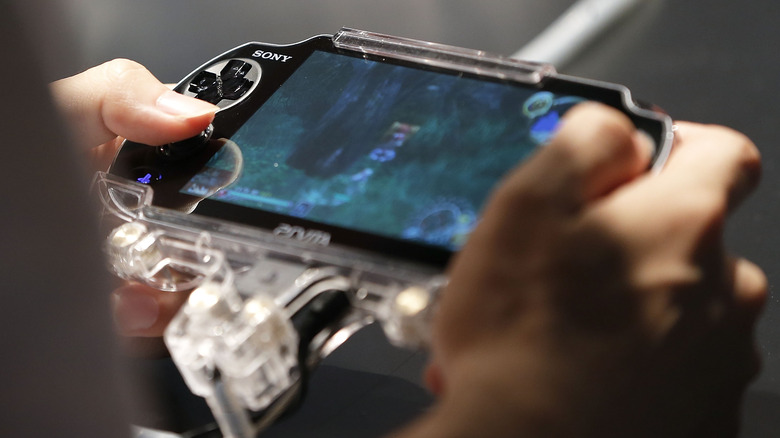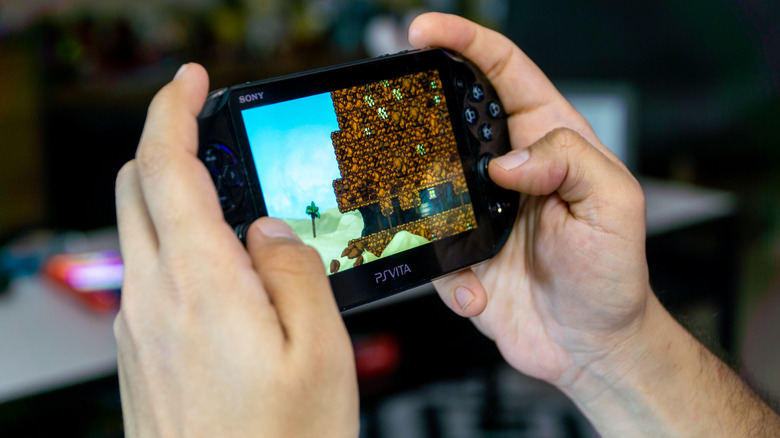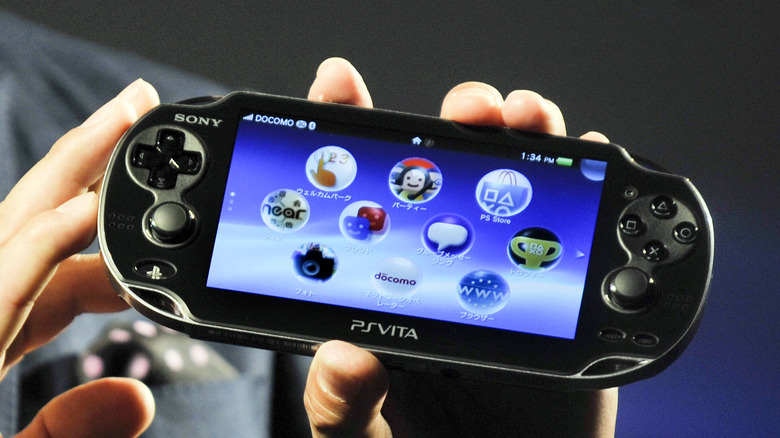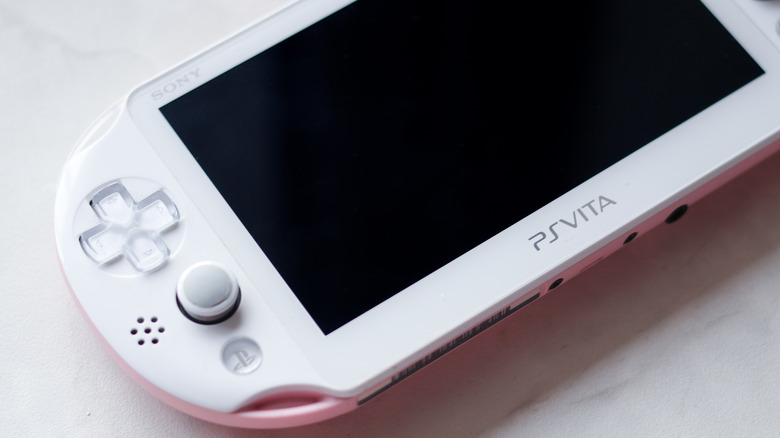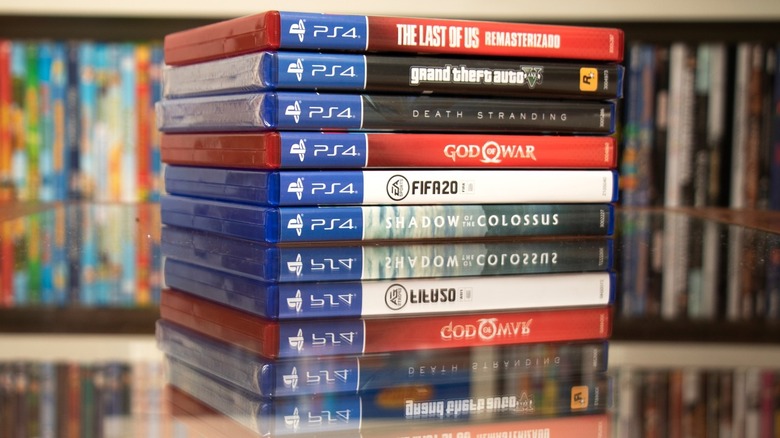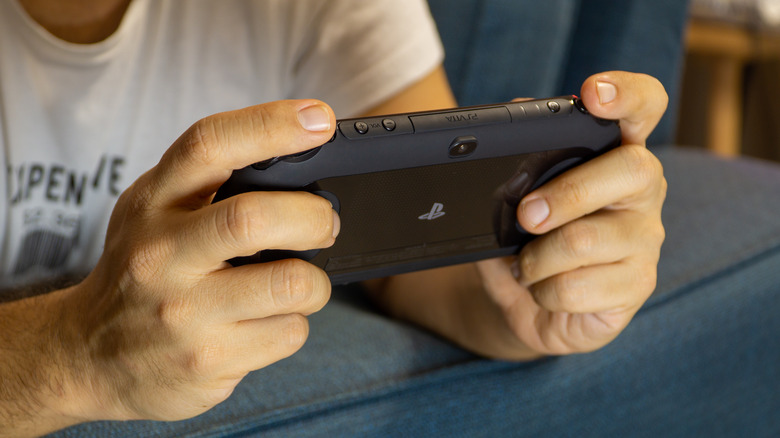The Reason Sony's PlayStation Vita Was A Failure
Few players have been able to dominate the handheld gaming market like Nintendo. From the polarizing Nokia NGage of old to new-age powerhouses like the Steam Deck, it's been tough for anyone to knock the company from atop its perch. Sony arguably had one of the best answers in the form of the original PlayStation Portable (also known as the PSP).
With a deep collection of classic franchises from which to both develop new games and port older ones, more powerful hardware than even Nintendo could manage, better multimedia options, and stronger third-party support from triple-A developers, it seemed like Sony would be a permanent anchor to its longtime rival as part of a two-headed giant in mobile gaming.
The hype for the sequel — the PlayStation Vita — was astronomical. It would build on the same formula that the original PSP thrived on, only with the promise of even better games thanks to its more powerful hardware. The PS Vita got off to a hot start as a result, but its momentum would sizzle down far quicker than anyone could imagine. Sony estimated it would sell 10 million units worldwide, but it barely crossed the 6 million mark by the end of its cycle. For comparison's sake, the PSP reportedly sold around 80 million units. Here are some reasons why this product — once thought to revolutionize mobile gaming — would eventually become a laughable vapor.
A brief history of the handheld console war
In 2004, Sony entered the handheld gaming sphere with the release of the PlayStation Portable (PSP) in Japan, which was followed by a launch in other markets in 2005. The portable console enjoyed some success and was a viable competitor to Nintendo's line of handheld gaming devices. It was also the most powerful handheld system at the time and came with an array of features like video and audio playback. Sony sold around 80 million PSPs, and eventually, it decided to release a successor to the system known as the PlayStation Vita.
The PS Vita was released in Japan in 2011 and then in the U.S. in 2012, as detailed in the original press release. Around this time was also when Nintendo released its 3DS system, and mobile gaming in general was on the rise thanks to smartphones. The PS Vita had a relatively good launch and 200,000 units were sold in the U.S. within the first month. However, it didn't take long for these sales to stall, and the numbers quickly dwindled over the following months, reported Ars Technica. In contrast, the Nintendo 3DS was enjoying immense success, taking a lot of attention away from the PS Vita during its lifespan.
PS Vita stumbled while the Nintendo 3DS forged its own path
During the rise in mobile gaming, Sony and Nintendo were attempting to compete in the market with their respective handhelds. However, each company had a different reaction to smartphone gaming. In response to a question asked about a Playstation Vita successor, Shuhei Yoshida, president of Sony Computer Entertainment Worldwide Studios, stated in a Q&A session at an EGX conference in 2015 that "the climate is not healthy for now because of the huge dominance in mobile gaming."
During this same time, Nintendo decided to make its 3DS handheld as irresistible as possible to potential buyers, launching plenty of great titles and eventually releasing new versions of the system, such as the 3DS XL. This was a good move for Nintendo, and it enjoyed immense success with the handheld console, selling around 74 million units (via Nintendo). Sony, on the other hand, seemed to ignore the Vita once it realized the console wasn't garnering the number of sales it had originally hoped for.
Companies pulled support for the failing Vita
As sales for the PS Vita grew weak, big game studios eventually decided to pull support for the device, meaning there was a huge lack of games being created for the system. This included the game series that was one of the main drives to the PSP, "Monster Hunter." Capcom opted to release "Monster Hunter" titles for the Nintendo 3DS instead during this time, pulling many consumers away from Sony's PS Vita in the process, as shown by sales data from Media Create. Both handhelds were priced at $249.99 when they launched, however, Nintendo didn't take as long as Sony to reduce the price for its handheld to draw in more buyers, as reported in the Guardian.
The lack of third-party support for the Vita was a huge obstacle for the system to overcome. Sony attempted to keep the console alive by turning to indie game developers in order to grow the PS Vita's library, according to Polygon. Although this strategy allowed the Vita to survive, it wasn't enough for the portable console to truly thrive and make its mark in video game history. The availability of smaller indie titles may have drawn a small and loyal fanbase, but the PS Vita was ultimately considered a commercial failure.
Sony couldn't support it well enough with its own games
Paltry third-party support was bad enough, but Sony had even more trouble making meaningful headway with its own library of games. The PS Vita's launch library was very limited, with only a couple of interesting or noteworthy games per genre. We'd expected this to change in time with Sony revitalizing some of its tried and true franchises in pocketable form, but even they didn't seem interested in putting forth much effort after launch. In fact, Sony engineers and execs admitted that most developers viewed the Vita as a secondary priority to the PS4 (via The Verge), making them hesitant to divert significant resources to the platform.
Sony would later resort to releasing PS One classics and PSP re-releases, while indie developers did a bulk of the work to keep some semblance of a release calendar intact. Even more insulting to PS Vita buyers was the fact that Sony regularly released PlayStation classics for its smartphones and rarely bothered to offer the same for its big-ticket handheld (via Sony). Speaking with Eurogamer in September 2014, Sony U.K. head Fergal Gara all but confirmed that the Vita was relegated as a "niche" device.
Will we ever see another PlayStation handheld?
Your guess is as good as ours. Clearly, there's still a strong market for portable gaming consoles as evidenced by the Nintendo Switch's success, not to mention the buzz around the Steam Deck (however hard it is to acquire still). Pitch in the billions of smartphones and tablets sold that inch toward console-quality graphics by the year, and we can safely say that mobile gaming isn't going anywhere. To its credit, Sony once tried to release its own gaming phone, the Xperia Play, but its lackluster sales prompted the console maker to target foreign platforms.
The Vita's value rested in its robust controls and its ability to serve as a companion to your PlayStation 4, which allowed you to play select titles remotely. That feature was pretty cool and well ahead of its time, but considering you could only (officially) use Remote Play if you were on the same network as the PS4, it was more novelty than killer — plus, you can now use that feature with a smartphone that you very likely own.
Ultimately, it wasn't enough to make up for the fact that the system had few viable games of its own, and with smartphone gaming becoming increasingly prominent at the time, there was little reason for anyone outside of die-hard, deep-pocketed Sony fans to consider buying a Vita.
